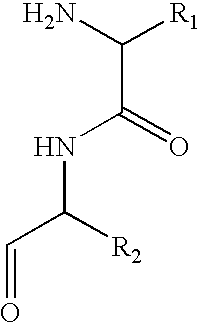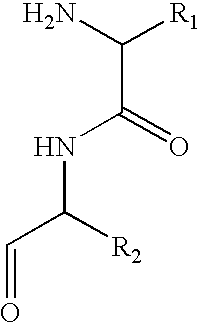Method for peptide and polypeptide purification and differential analysis
a polypeptide and purification method technology, applied in the field of proteomics, can solve the problems of inability to quantitatively capture peptides of this length using existing purification methods, inability to identify short (6 amino acid) peptides, and inability to identify short peptides
- Summary
- Abstract
- Description
- Claims
- Application Information
AI Technical Summary
Benefits of technology
Problems solved by technology
Method used
Image
Examples
example 1
Extraction of Major Histocompatibility Complex (MHC) Molecules and Associated Peptides
[0037] Pan MHC class I molecules are isolated from aliquots of 1-5×108 tumor and non-tumor cells after solubilization in buffer containing 1% NP-40 and a protease inhibitor cocktail. Affinity chromatography is performed using the monoclonal antibody W6 / 32, which selectively recognizes the MHC class I molecules. Bound material is eluted in 0.2N acetic acid, further acidified to 10% acetic acid, and boiled for 5 minutes. Low molecular weight peptides are separated from the HLA-A68 heavy chain, β2 microglobulin (β2m), and Ig heavy and light chains by ultrafiltration through a Millipore filter with a 5000 Dalton exclusion limit.
example 2
First Round Fractionation of MHC-Associated Peptides by HPLC
[0038] Filtered samples undergo a first dimension fractionation via HPLC. A 1 mm×250 mm PLRP-S 100A° Polymer column is used with an Applied Biosystems Model 140B Separations System. Solvent A is 2% ACN in H2O+0.1% TFA and solvent B is 80% ACN in H2O+0.09% TFA using a gradient of 2% B to 60% B in 60 minutes at a flow rate of 50 ul / min. Column effluent is monitored at 214 nm and fractions are collected at one minute intervals.
example 3
Isolation of MHC-Associated Peptides Using DITC Glass
[0039] Fractions are reduced to one half of their original volume using vacuum centrifugation without heat. They are then diluted to 100 microliters with 5% triethylamine in 50 / 50 isopropyl alcohol / water. Approximately 10 ug of isothiocyanate glass (DITC) is placed into a 0.1 um Durapore membrane spin filter for each fraction to be further analyzed. The fraction volume is added to the DITC in the spin filter and allowed to incubate for 45 minutes at 45° C. with gentle shaking. Only chemical molecules containing primary amines will react and covalently bind to the DITC derivatized glass. All filter units then undergo centrifugation at 10,000 rpm for 2 minutes. The filtrate volume is discarded. The DITC glass is then washed several times with organic and ionic buffers at neutral pH repeating the steps above: add buffer, shake, centrifuge, discard filtrate. Finally, the peptides are released from the DITC glass by the addition of 10...
PUM
| Property | Measurement | Unit |
|---|---|---|
| temperature | aaaaa | aaaaa |
| temperature | aaaaa | aaaaa |
| molecular weight | aaaaa | aaaaa |
Abstract
Description
Claims
Application Information
 Login to View More
Login to View More - R&D
- Intellectual Property
- Life Sciences
- Materials
- Tech Scout
- Unparalleled Data Quality
- Higher Quality Content
- 60% Fewer Hallucinations
Browse by: Latest US Patents, China's latest patents, Technical Efficacy Thesaurus, Application Domain, Technology Topic, Popular Technical Reports.
© 2025 PatSnap. All rights reserved.Legal|Privacy policy|Modern Slavery Act Transparency Statement|Sitemap|About US| Contact US: help@patsnap.com


